tow TOYOTA tC 2011 Owners Manual (in English)
[x] Cancel search | Manufacturer: TOYOTA, Model Year: 2011, Model line: tC, Model: TOYOTA tC 2011Pages: 473, PDF Size: 10.91 MB
Page 1 of 473

TABLE OF CONTENTS
1
1Before drivingAdjusting and operating features such as door locks,
mirrors, and steering column
2When drivingDriving, stopping and safe-driving information
3Interior fea-
turesAir conditioning as well as other interior features for a
comfortable driving experience
4Maintenance
and careCleaning and protecting your vehicle, performing do-it-
yourself maintenance, and maintenance information
5When trouble
arisesWhat to do if the vehicle needs to be towed, gets a flat
tire, or is involved in an accident
6Vehicle
specificationsDetailed vehicle information
7For ownersReporting safety defects for U.S. owners, and seat belt
and SRS airbag instructions for Canadian owners
IndexAlphabetical listing of information contained in this
manual
Page 3 of 473
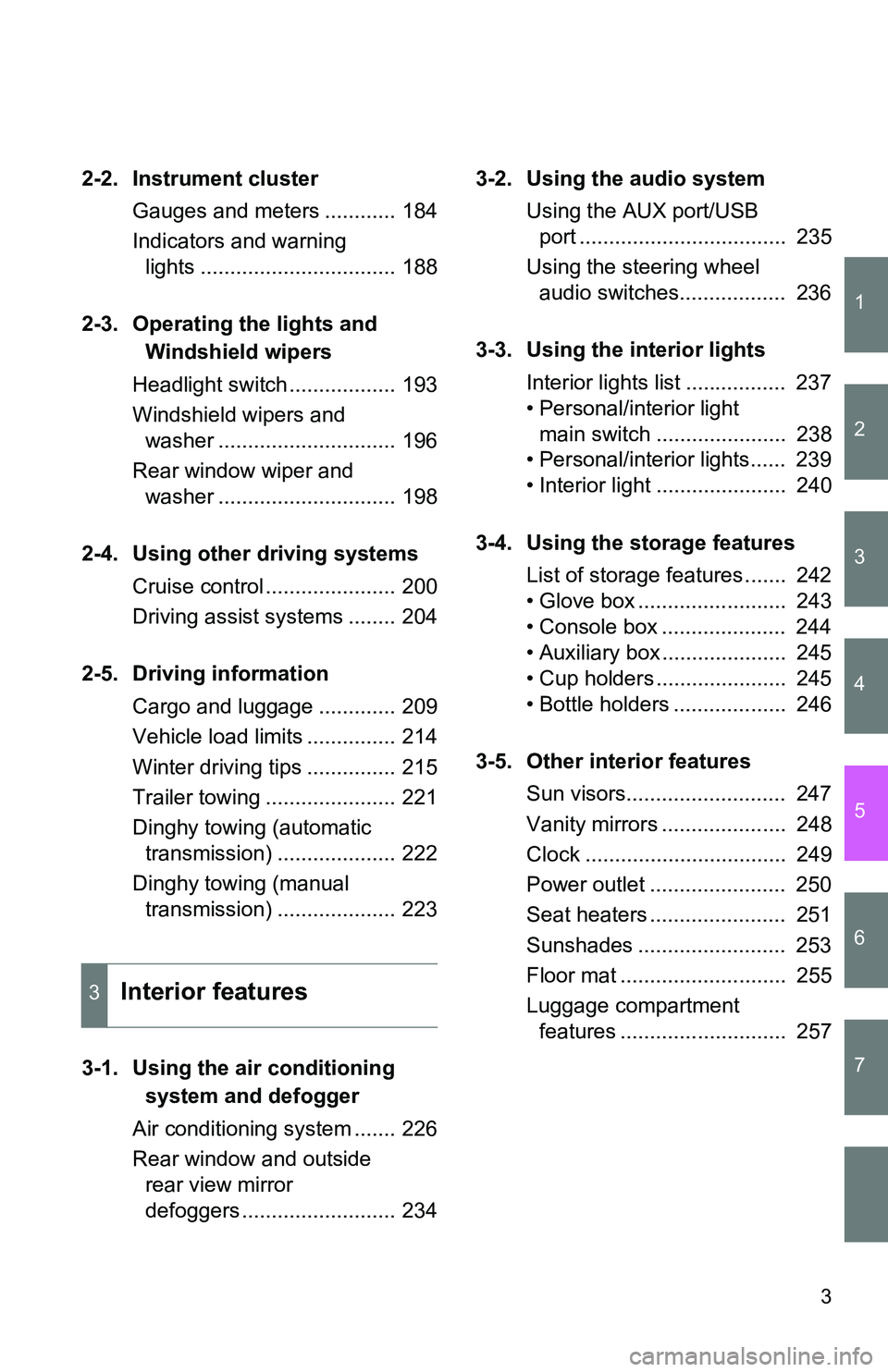
1
2
3
4
5
6
7
3
2-2. Instrument clusterGauges and meters ............ 184
Indicators and warning lights ................................. 188
2-3. Operating the lights and Windshield wipers
Headlight switch .................. 193
Windshield wipers and washer .............................. 196
Rear window wiper and washer .............................. 198
2-4. Using other driving systems Cruise control ...................... 200
Driving assist systems ........ 204
2-5. Driving information Cargo and luggage ............. 209
Vehicle load limits ............... 214
Winter driving tips ............... 215
Trailer towing ...................... 221
Dinghy towing (automatic transmission) .................... 222
Dinghy towing (manual transmission) .................... 223
3-1. Using the air conditioning system and defogger
Air conditioning system ....... 226
Rear window and outside rear view mirror
defoggers .......................... 234 3-2. Using the audio system
Using the AUX port/USB port ................................... 235
Using the steering wheel audio switches.................. 236
3-3. Using the interior lights Interior lights list ................. 237
• Personal/interior light main switch ...................... 238
• Personal/interior lights...... 239
• Interior light ...................... 240
3-4. Using the storage features List of storage features ....... 242
• Glove box ......................... 243
• Console box ..................... 244
• Auxiliary box ..................... 245
• Cup holders ...................... 245
• Bottle holders ................... 246
3-5. Other interior features Sun visors........................... 247
Vanity mirrors ..................... 248
Clock .................................. 249
Power outlet ....................... 250
Seat heaters ....................... 251
Sunshades ......................... 253
Floor mat ............................ 255
Luggage compartment features ............................ 257
3Interior features
Page 4 of 473
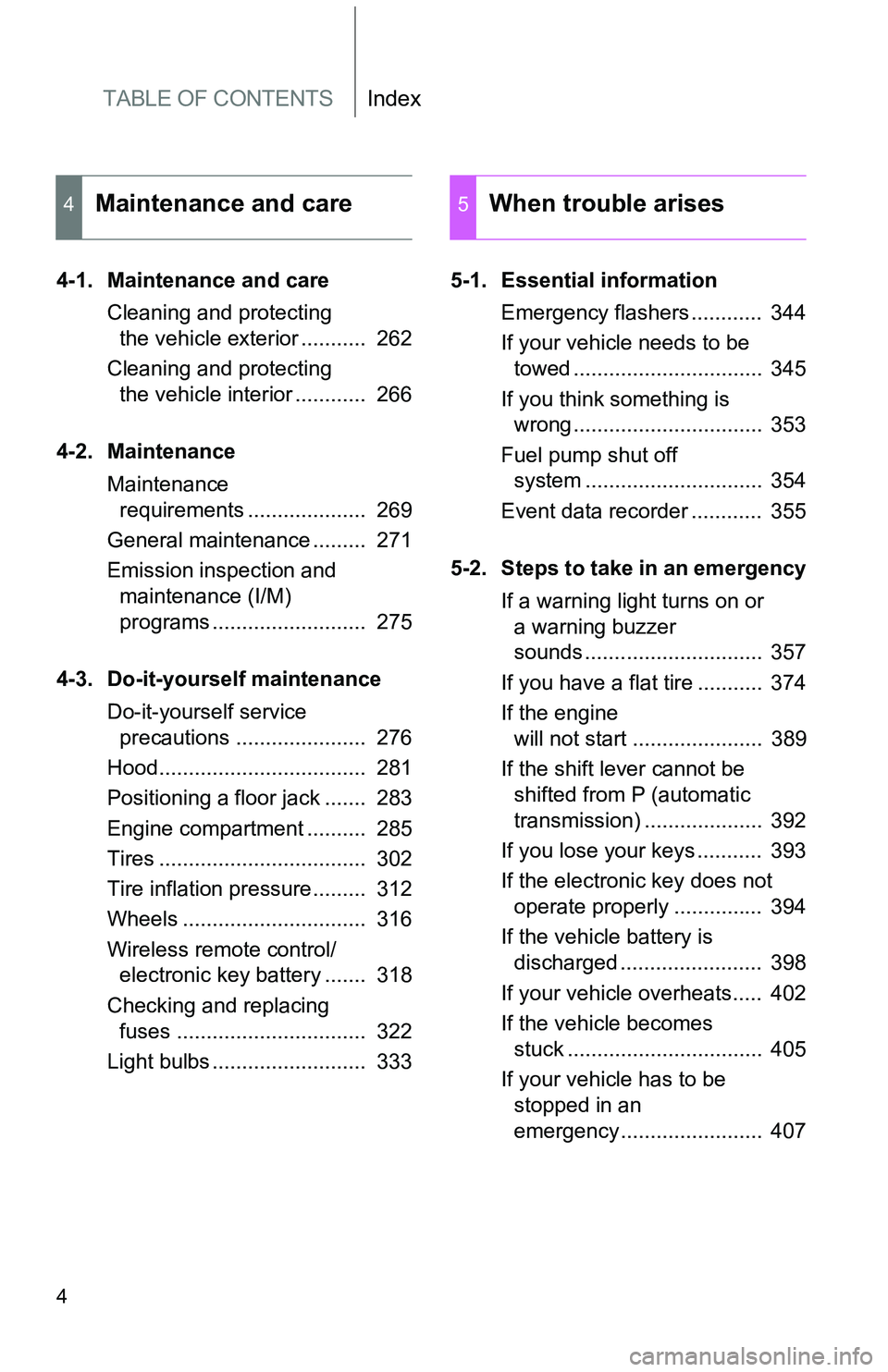
TABLE OF CONTENTSIndex
4
4-1. Maintenance and careCleaning and protecting the vehicle exterior ........... 262
Cleaning and protecting the vehicle interior ............ 266
4-2. Maintenance Maintenance requirements .................... 269
General maintenance ......... 271
Emission inspection and maintenance (I/M)
programs .......................... 275
4-3. Do-it-yourself maintenance Do-it-yourself service precautions ...................... 276
Hood................................... 281
Positioning a floor jack ....... 283
Engine compartment .......... 285
Tires ................................... 302
Tire inflation pressure......... 312
Wheels ............................... 316
Wireless remote control/ electronic key battery ....... 318
Checking and replacing fuses ................................ 322
Light bulbs .......................... 333 5-1. Essential information
Emergency flashers ............ 344
If your vehicle needs to be towed ................................ 345
If you think something is wrong ................................ 353
Fuel pump shut off system .............................. 354
Event data recorder ............ 355
5-2. Steps to take in an emergency If a warning light turns on or a warning buzzer
sounds .............................. 357
If you have a flat tire ........... 374
If the engine will not start ...................... 389
If the shift lever cannot be shifted from P (automatic
transmission) .................... 392
If you lose your keys ........... 393
If the electronic key does not operate properly ............... 394
If the vehicle battery is discharged ........................ 398
If your vehicle overheats..... 402
If the vehicle becomes stuck ................................. 405
If your vehicle has to be stopped in an
emergency........................ 407
4Maintenance and care5When trouble arises
Page 41 of 473

41
1-2. Opening, closing and locking the doors
1
Before driving
■
Conditions affecting operation
The smart key system uses weak radio waves. In the following situations,
the communication between the electronic key and the vehicle may be
affected, preventing the smart key system and wireless remote control from
operating properly. (Ways of coping P. 394)
● When the electronic key battery is depleted
● Near a TV tower, electric power plant, gas station, radio station, large dis-
play, airport or other facility that generates strong radio waves or electri-
cal noise
● When carrying a portable radio, ce llular phone, cordless phone or other
wireless communication device
● When the electronic key is in contact with, or is covered by the following
objects
• Cards to which aluminum foil is attached
• Cigarette boxes that have aluminum foil inside
• Metallic wallets or bags
• Coins
• Hand warmers made of metal
• Media such as CDs and DVDs
● When multiple electronic keys are in the vicinity
● When another wireless key (that emits radio waves) is being used nearby
● When carrying or using the electronic key together with the following
devices that emit radio waves
• Another vehicle’s electronic key
• A wireless key that emits radio waves
• Personal computers or personal digital assistants (PDAs)
• Digital audio players
• Portable game systems
● If window tint with a metallic content or metallic objects are attached to
the rear window
Page 50 of 473

50 1-2. Opening, closing and locking the doors
■Security feature
If a door is not opened within approximately 60 seconds after the vehicle is
unlocked, the security feature automatically locks the vehicle again.
■ Conditions affecting operation
The wireless remote control function may not operate normally in the follow-
ing situations:
Vehicles without a smart key system
●Near a TV tower, radio station, electr ic power plant, airport or other facil-
ity that generates strong radio waves
● When carrying a portable radio, cell ular phone or other wireless commu-
nication devices
● When multiple wireless keys are in the vicinity
● When the wireless key is in contact with, or is covered by, a metallic
object
● When a wireless key (that emits radio waves) is being used nearby
● When the wireless key has been left near an electrical appliance such as
a personal computer
Vehicles with a smart key system
P. 4 1
■ If the wireless remote control does not operate properly (vehicles with
a smart key system)
Locking and unlocking the doors: Use the mechanical key. ( P. 394)
■ Key battery depletion
Vehicles without a smart key system
If the wireless remote control function does not operate, the battery may be
depleted. Replace the battery when necessary. ( P. 318)
Vehicles with a smart key system
P. 4 5
Page 75 of 473
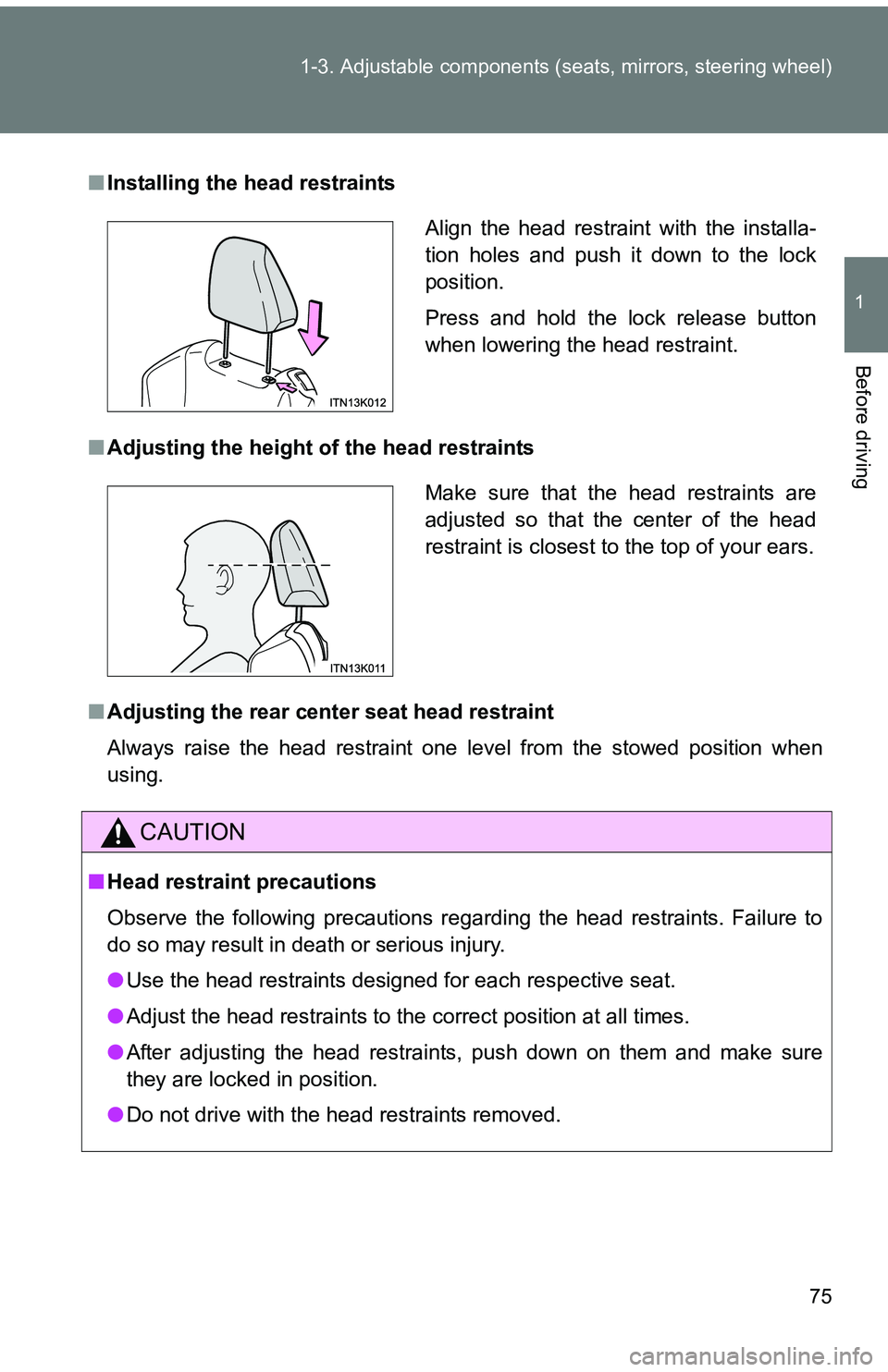
75
1-3. Adjustable components (s
eats, mirrors, steering wheel)
1
Before driving
■Installing the head restraints
■ Adjusting the height of the head restraints
■ Adjusting the rear cent er seat head restraint
Always raise the head restraint one level from the stowed position when
using.
CAUTION
■ Head restraint precautions
Observe the following precautions regarding the head restraints. Failure to
do so may result in death or serious injury.
●Use the head restraints designed for each respective seat.
● Adjust the head restraints to the correct position at all times.
● After adjusting the head restraints, push down on them and make sure
they are locked in position.
● Do not drive with the head restraints removed.
Align the head restraint with the installa-
tion holes and push it down to the lock
position.
Press and hold the lock release button
when lowering the head restraint.
Make sure that the head restraints are
adjusted so that the center of the head
restraint is closest to the top of your ears.
Page 111 of 473

111
1-7. Safety information
1
Before driving
CAUTION
■
SRS airbag precautions
Observe the following precautions regarding the SRS airbags.
Failure to do so may cause death or serious injury.
●The driver and all passengers in the vehicle must wear their seat belts
properly.
The SRS airbags are supplemental devices to be used with the seat belts.
● The SRS driver airbag deploys with considerable force, and can cause
death or serious injury especially if the driver is very close to the airbag.
The National Highway Traffic Safety Administration (NHTSA) advises:
Since the risk zone for the driver’s airbag is the first 2 - 3 in. (50 - 75 mm)
of inflation, placing yourself 10 in. (250 mm) from your driver airbag pro-
vides you with a clear margin of safety. This distance is measured from the
center of the steering wheel to your breastbone. If you sit less than 10 in.
(250 mm) away now, you can change your driving position in several
ways:
• Move your seat to the rear as far as you can while still reaching the pedals comfortably.
• Slightly recline the back of the seat. Although vehicle designs vary, many drivers can achieve the 10 in.
(250 mm) distance, even with the driver seat all the way forward, sim-
ply by reclining the back of the seat somewhat. If reclining the back of
your seat makes it hard to see the road, raise yourself by using a firm,
non-slippery cushion, or raise the seat if your vehicle has that feature\
.
• If your steering wheel is adjustable, tilt it downward. This points the air- bag toward your chest instead of your head and neck.
The seat should be adjusted as recommended by NHTSA above, while
still maintaining control of the foot pedals, steering wheel, and your view of
the instrument panel controls.
Page 113 of 473
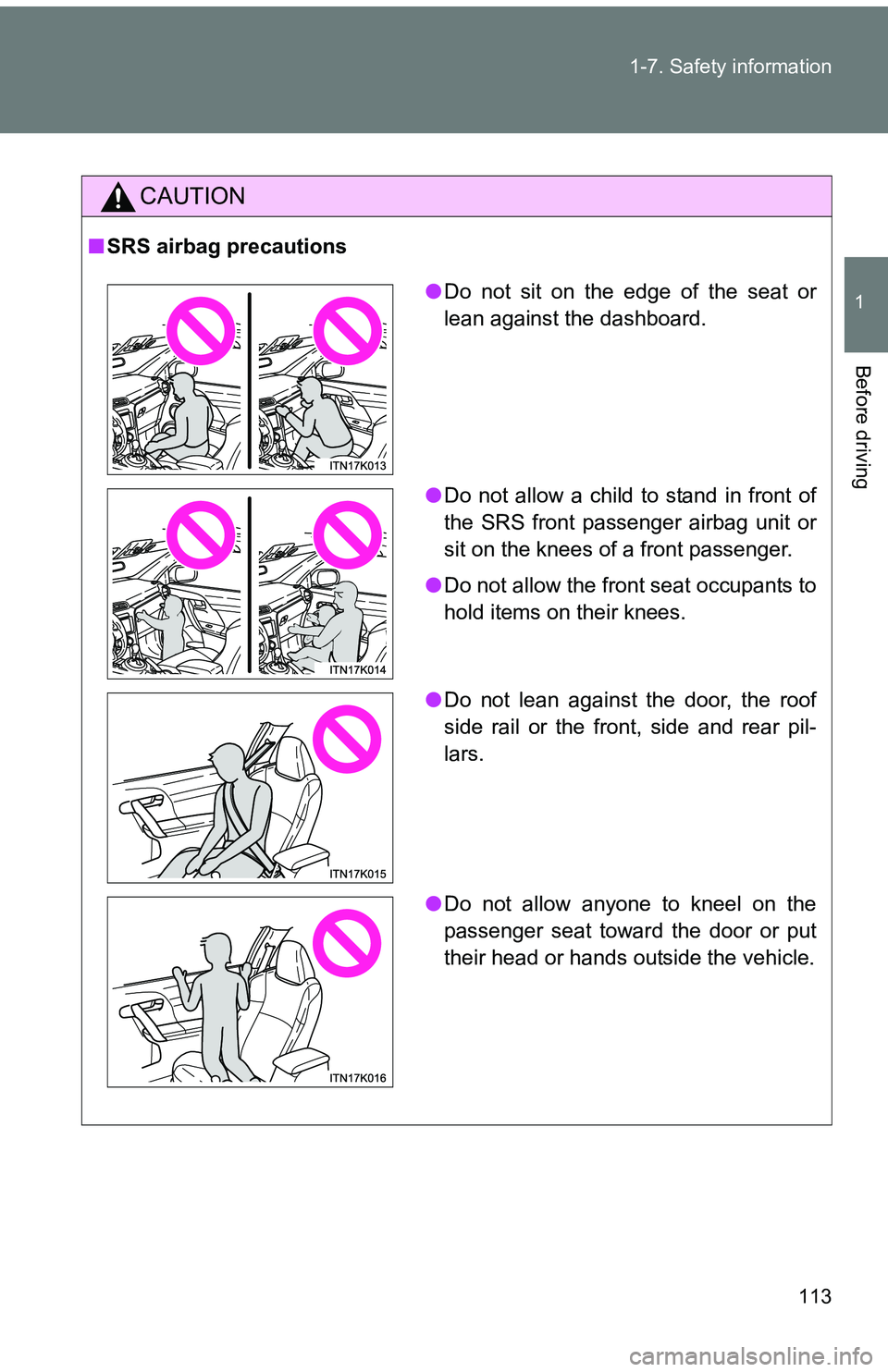
113
1-7. Safety information
1
Before driving
CAUTION
■
SRS airbag precautions
●Do not sit on the edge of the seat or
lean against the dashboard.
● Do not allow a child to stand in front of
the SRS front passenger airbag unit or
sit on the knees of a front passenger.
● Do not allow the front seat occupants to
hold items on their knees.
● Do not lean against the door, the roof
side rail or the front, side and rear pil-
lars.
● Do not allow anyone to kneel on the
passenger seat toward the door or put
their head or hands outside the vehicle.
Page 143 of 473
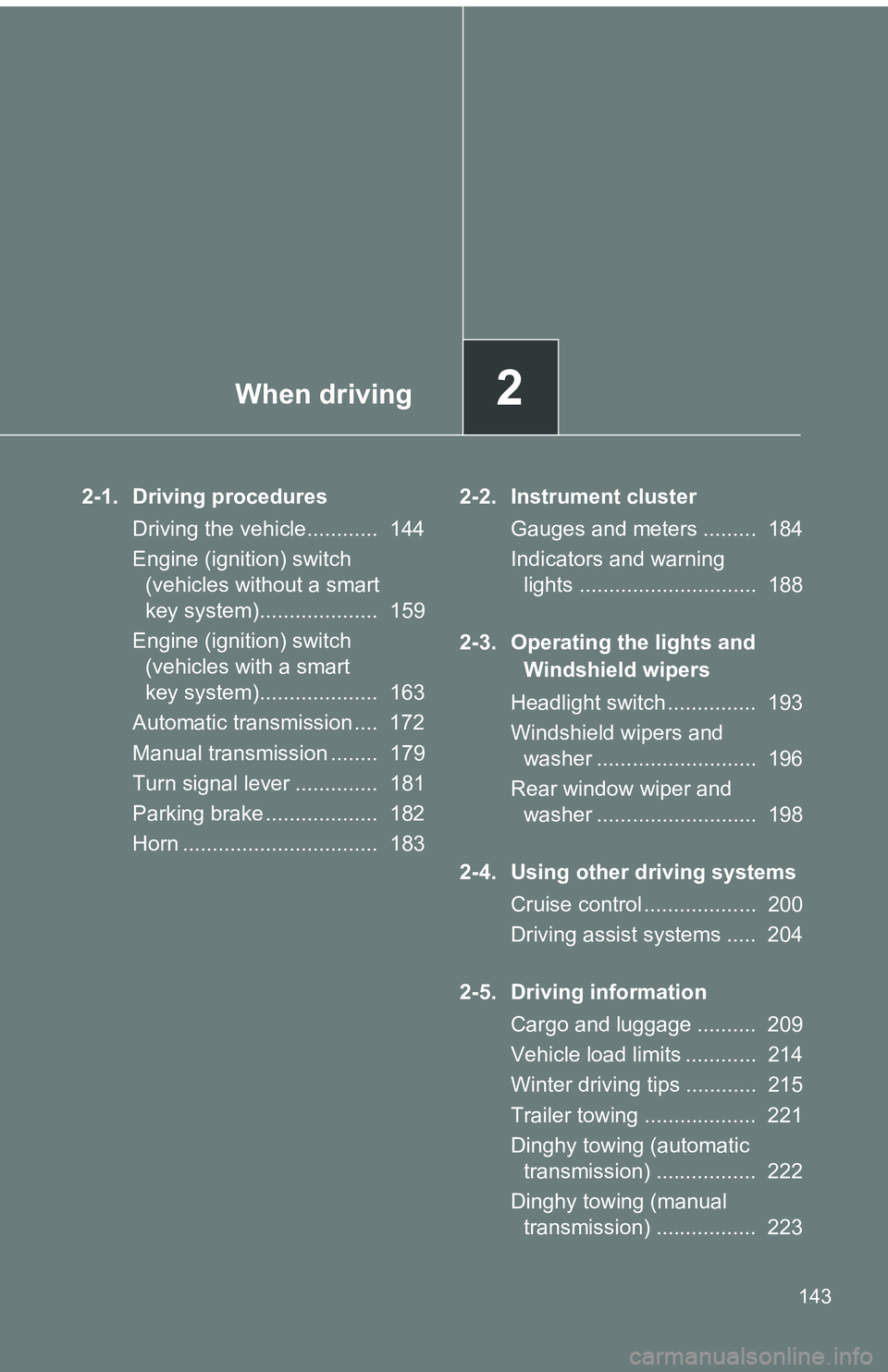
When driving2
143
2-1. Driving proceduresDriving the vehicle............ 144
Engine (ignition) switch (vehicles without a smart
key system).................... 159
Engine (ignition) switch (vehicles with a smart
key system).................... 163
Automatic transmission .... 172
Manual transmission ........ 179
Turn signal lever .............. 181
Parking brake ................... 182
Horn ................................. 183 2-2. Instrument cluster
Gauges and meters ......... 184
Indicators and warning lights .............................. 188
2-3. Operating the lights and Windshield wipers
Headlight switch ............... 193
Windshield wipers and washer ........................... 196
Rear window wiper and washer ........................... 198
2-4. Using other driving systems Cruise control ................... 200
Driving assist systems ..... 204
2-5. Driving information Cargo and luggage .......... 209
Vehicle load limits ............ 214
Winter driving tips ............ 215
Trailer towing ................... 221
Dinghy towing (automatic transmission) ................. 222
Dinghy towing (manual transmission) ................. 223
Page 177 of 473

177
2-1. Driving procedures
2
When driving
■
Shift ranges and their functions
●Automatically selecting gears between 1 and 6 according to
vehicle speed and driving conditions. However, the gear is lim-
ited according to selected shift range.
● You can choose from 6 levels of engine braking force.
● A lower shift range will provide greater engine br aking force than
a higher shift range, and the engine speed will also increase.
■Paddle shift switch (if equipped)
●When the “-” paddle shift switch is operated in the D position, a shift
range will be automatically selected. The highest gear of the first shift
range will be one gear lower than the gear in use during normal D posi-
tion driving.
● Automatic deactivation of shift range selection in the D position
Shift range selection in the D position will be deactivated in the following
situations:
• The “+” paddle shift switch is held down for a period of time
• When the vehicle comes to a stop
• If the accelerator pedal is depressed for longer than a certain period of
time in one shift range
■ S mode
●When the shift range is 5 or lower, holding the shift lever toward “+” sets
the shift range to 6.
● To prevent excessive engine speed, a function was adopted that auto-
matically selects a higher shift range before the engine speed becomes
too high.
● To protect the automatic transmission, a function is adopted that auto-
matically selects a higher shift range when the fluid temperature is high.